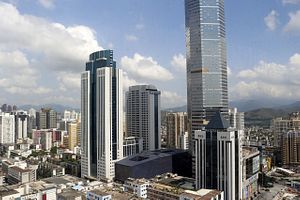By Jason Hung

In the past four decades, Shenzhen – the city of China known for its proximity to Hong Kong – has rapidly been developing technologically and economically. Shenzhen is now a high-tech hub, the home of Chinese technology giants, including Huawei, Tencent, and DJI. Shenzhen’s GDP overtook Hong Kong, primarily due to the booming tech industry, in 2018.
Chinese Communist Party (CCP) leader Xi Jinping recently announced that Shenzhen will serve as the heart of the Greater Bay Area, an integrated region that includes Hong Kong and Macau. Under Xi’s plan, Hong Kong, after experiencing over a year of protests sparked by a controversial extradition bill, will be sidelined as China focuses primarily on developing Shenzhen. It is therefore crucial to understand whether Shenzhen can overtake Hong Kong as a Chinese “world city.”
Due to Shenzhen’s proximity to Hong Kong, Shenzhen has already been used as a base for Chinese leaders to supervise Hong Kong’s political and economic development. Future Hong Kong chief executives, government officials, and police officiers can conveniently visit Shenzhen to attend the anniversary celebrations of the People’s Republic of China (PRC) as well as training sessions, learning Beijing’s upcoming policy developments. Such a move can facilitate Hong Kong’s mainland-ization and ensure that China’s national and regional political stability can be maximized.
To boost Shenzhen’s global standing, Beijing plans to massively inject funds into the local high-tech industry. Law Ka-chung, a former Bank of Communications analyst and economics professor at the City University of Hong Kong, argued, “Shenzhen is all about developing high-tech, but Hong Kong can’t afford to do that because it has had a financial reversal of fortunes.”
Unlike Beijing and Shanghai where state-owned enterprises aggregate and Beijing’s dogmas need to be strictly followed, Shenzhen – a city where private enterprises are concentrated – has been growingly championing for market-oriented regulations, enabling the local market to open the door to a vast variety of enterprises and strengthening its vitality and adaptability. Shenzhen, with its innovation-driven plan, will help China drive national economic growth through technological improvement and, if successful, lift China’s technology on a par with its major rival – the United States.
However, the state capital allocation system is unlikely to be compatible with financial freedom, implying that it may be difficult for Shenzhen to become a global financial center in the model of Hong Kong. That being said, Hong Kong does not necessarily continue to enjoy explicit edges as a financial center over mainland Chinese cities due to the outbreak of the Sino-U.S. trade war. The war has led to a drain on Hong Kong’s U.S. dollar liquidity – a key selling point as a global financial hub. The Hong Kong Monetary Authority’s USD foreign exchange reserves have plunged from 46 percent to 41 percent.
In the long term, Xi has decided to develop the renminbi – China’s own currency – as an international reserve currency. If that effort succeeds, Beijing can build its own financial center in Shenzhen rather than relying on Hong Kong.
In order to make Shenzhen the next global financial center, however, Beijing will still have to tackle several obstacles. In Hong Kong but not Shenzhen, there is free internet access, freedom of speech, the rule of law, and free flow of capital. If these values of civil liberty cannot be offered in Shenzhen, can the Chinese high-tech hub attract a raft of foreign investments just like Hong Kong?
Jason Hung is a Ph.D. in Sociology candidate at the University of Cambridge.
No comments:
Post a Comment